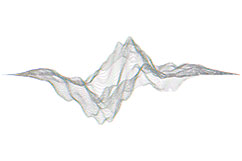Distortion can be a confusing topic to understand as it is impossible to convey in a line or two of a specification table. For example, you are likely familiar with seeing a distortion specification on an amplifier. It is generally expressed as a percentage; 150 watts at 0.1% THD+N as an example. So, it would seem to make sense that an amplifier rated at 150 watts at 0.02% THD+N would sound, well, less distorted.
But in reality, neither of these distortion percentages are audible. In our testing using non-harmonically related tones with the listening being done in an anechoic chamber the lowest threshold for detecting distortion was 0.1% and only at 10kHz and above.
If the source is music with the listening being done in a regular room the threshold is much higher than this; study here.
Going back to our distortion spec of 150 watts at 0.02% THD+N, what you will find is that the distortion will rise very quickly as you cross the rated power output, so if you turn up the volume to the point where you require more than 150 watts the distortion will rise at an exponential rate as a percentage. This is known as amplifier clipping and is very audible.
When an amplifier clips the sound becomes harsh and you want to turn it down.
To add another layer of complexity to this, music is dynamic in nature and accurate reproduction of these dynamics is very important to listener enjoyment. However, our standard specification of continuous RMS watts to judge amplifier power is very misleading. The real question is how much power can the amplifier produce without clipping for very short bursts.
Things like the amount of storage capacitance in the amplifier can be a good indicator of its ability to produce many times the continuous power for a short amount of time, resulting in accurate and distortion-free reproduction of dynamics.
Since power is logarithmic, the amount of power required to produce a 12dB dynamic peak will be 16 times the continuous power level you are listening at. This means if your amplifier has no dynamic headroom above its continuous power rating you have to divide the power rating by 16 to have enough headroom for a clean 12dB peak. Now our 150-watt amplifier has a usable continuous output for clean music reproduction of 9.4 watts.
The above discussed one aspect of non-linear distortion. But there is also linear distortion which in many ways can be worse than non-linear distortion, even if subtler, because it will always be present in an imperfect system. You cannot turn down the volume to get rid of linear distortion. Linear distortion would include an imperfect amplitude response curve from a loudspeaker.
Again, this cannot be boiled down to a one-line specification. We have likely all seen speaker specifications like 50Hz – 20kHz +/- 3 dB. This specification will represent the on-axis frequency response (hopefully measured in an anechoic chamber but not likely). Unfortunately, the on-axis frequency response is only one of many amplitude response curves necessary to evaluate the linearity of a speaker. What you really need is the Listening Window curve, the Sound Power curve, and the Directivity Index. Note that the Directivity Index will be the inverse of the Sound Power curve if the Listening Window curve is linear. Without all of this information you have no idea how much your loudspeaker is distorting the sound.




